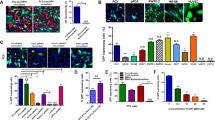Abstract
Patients with certain genetic disorders can be cured by bone marrow transplantation1,2. However, as prospective donors do not exist for most patients with potentially curable genetic abnormalities, an alternative treatment for such patients involves the transfer of cloned genes into the patient's haematopoietic stem cells followed by re-infusion of the treated cells3. Retroviral vectors provide an efficient means for transferring genes into mammalian cells and have been used to transfer genes into mouse haematopoietic cells4–8. We have now produced amphotropic retroviral vectors containing either the bacterial gene for neomycin resistance or a mutant dihydrofolate reductase gene that confers resistance to methotrexate and have used these vectors to infect and confer drug resistance to human haematopoietic progenitor cells in vitro. Transfer could be demonstrated in the absence of helper virus by using an amphotropic retrovirus packaging cell line, PA12 (ref. 9). These studies are an important step towards the eventual application of retrovirus-mediated gene transfer to human gene therapy and for molecular approaches to the study of human haematopoiesis.
This is a preview of subscription content, access via your institution
Access options
Subscribe to this journal
Receive 51 print issues and online access
$199.00 per year
only $3.90 per issue
Buy this article
- Purchase on Springer Link
- Instant access to full article PDF
Prices may be subject to local taxes which are calculated during checkout
Similar content being viewed by others
References
Bortin, M. M. & Rim, A. A. J. Am. med. Ass. 238, 591–600 (1977).
Thomas, E. D. et al. Lancet ii, 227–229 (1982).
Anderson, W. F. Science 226, 401–409 (1984).
Joyner, A. Keller, R. A., Phillips, A. & Bernstein, A. Nature 305, 556–558 (1983).
Miller, A. D., Eckner, R. J., Jolly, D. J., Friedmann, T. & Verma, I. Science 225, 630–632 (1984).
Williams, D. A., Lemischka, I. R., Nathan, D. G. & Mulligan, R. C. Nature 310, 476–480 (1984).
Dick, J. E., Magli, R. C., Huszar, D., Phillips, R. A. & Bernstein, A. Cell 42, 1–79 (1985).
Keller, G., Paige, C., Gilboa, E. & Wagner, E. F. Nature 318, 149–154 (1985).
Miller, A. D., Law, M. F. & Verma, I. M. Molec. cell. Biol 5, 431–437 (1985).
Levitt, P. & Quesenberry, L. New Engl. J. Med. 301, 755–760, 819–823, 868–872 (1979).
Pike, B. L. & Robinson, W. A. J. cell. Physiol. 76, 77–84 (1970).
Stephenson, J. R., Axelrad, A. A., McLeod, D. L. & Shreeve, M. M. Proc. natn. Acad. Sci. U.S.A. 68, 1542–1546 (1971).
Fauser, A. A. & Messner, H. A. Blood 52, 1243–1248 (1978).
Colbère-Garapin, F., Horodniceanu, F., Kourilsky, P. & Garapin, A. C. J. molec. Biol. 150, 1–14 (1981).
Simonsen, C. C. & Levinson, A. D. Proc. natn. Acad. Sci. U.S.A. 80, 2495–2499 (1983).
Miller, A. D., Trauber, D. R. & Buttimore, C. Somatic Cell molec. Genet. 12, 175–183 (1986).
Koizumi, S. et al. Expl Hemat. 8, 635–640 (1980).
Chabner, B. & Young, R. C. J. clin. Invest. 52, 1804–1811 (1973).
Kwok, W. W., Schuening, F., Stead, R.B. & Miller, A. D. Proc. natn. Acad. Sci. U.S.A. (in the press).
Rothstein, L., Pierce, J. H., Klassen. V. & Greenberger, J. Blood 65, 744–752 (1985).
Gruber, H. E. et al. Science 230, 1057–1061 (1985).
Mann, R., Mulligan, R. C. & Baltimore, D. Cell 33, 153–159 (1983).
Andrews, R. G., Torok-Storb, B. & Bernstein, I. D. Blood 62, 124–132 (1983).
Schlunk, T. & Schleyer, M. Expl Hemat. 8, 179–184 (1980).
Author information
Authors and Affiliations
Rights and permissions
About this article
Cite this article
Hock, R., Miller, A. Retrovirus-mediated transfer and expression of drug resistance genes in human haematopoietic progenitor cells. Nature 320, 275–277 (1986). https://doi.org/10.1038/320275a0
Issue Date:
DOI: https://doi.org/10.1038/320275a0
This article is cited by
-
Any closer to successful therapy of multiple myeloma? CAR-T cell is a good reason for optimism
Stem Cell Research & Therapy (2021)
-
Novel CAR T therapy is a ray of hope in the treatment of seriously ill AML patients
Stem Cell Research & Therapy (2021)
-
Genetically engineered T cells for cancer immunotherapy
Signal Transduction and Targeted Therapy (2019)
-
Rapid titration of retroviral vectors using a β-lactamase protein fragment complementation assay
Gene Therapy (2013)
-
Gene therapy with drug resistance genes
Cancer Gene Therapy (2006)
Comments
By submitting a comment you agree to abide by our Terms and Community Guidelines. If you find something abusive or that does not comply with our terms or guidelines please flag it as inappropriate.



